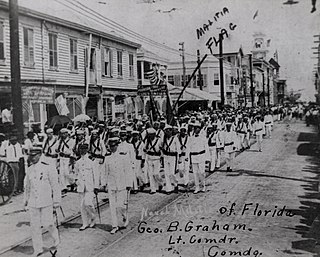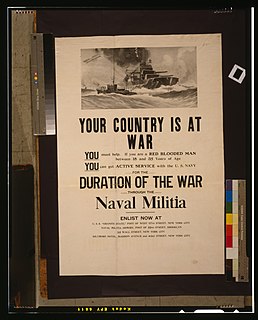
State defense forces (SDF); also known as state military, state military force(s), state guards, state militias, or state military reserves) in the United States are military units that operate under the sole authority of a state government. State defense forces are authorized by state and federal law and are under the command of the governor of each state.
The Uniform Code of Military Justice is the foundation of military law in the United States. It was established by the United States Congress in accordance with the authority given by the United States Constitution in Article I, Section 8, which provides that "The Congress shall have Power....To make Rules for the Government and Regulation of the land and naval forces".

A naval militia in the United States is a reserve military organization administered under the authority of a state government. It is often composed of Navy, Marine Corps, and Coast Guard reservists, retirees and volunteers. They are distinguishable from the U.S. Coast Guard Auxiliary which is a federally chartered civilian volunteer component of the U.S. Coast Guard and falls under the command of the Commandant of the Coast Guard through the Chief Director of the Auxiliary, and the United States Maritime Service and United States Merchant Marine, both of which are federal maritime services.
North Carolina State Defense Militia is the currently inactive state defense force of North Carolina.

The Alaska Naval Militia (AKNM) is the official naval militia of the state of Alaska. The Alaska Naval Militia falls under control of the state of Alaska. The legal basis for the naval militia comes from both federal and state law.

The Florida Naval Militia was the official naval militia of the state of Florida. Naval militias were organized as naval parallels to the National Guard as dual federal and state obligations, with the naval militias normally being under state control but subject to federal activation. The Florida Naval Militia was active during three periods in Florida history: between 1897 and 1903; between 1911 and 1917; and between 1934 and 1941.

The South Carolina Naval Militia (SCNM) is the naval militia of the state of South Carolina. The SCNM is a naval unit organized at state level and primarily composed of Navy and Marine Corps reservists who serve simultaneously as federal and state level reservists. The SCNM can be deployed by the Governor of South Carolina to assist in emergency response or in homeland security operations.
The Georgia Naval Militia (GNM) is the legally-authorized but currently inactive naval militia of the U.S. state of Georgia. The Georgia Naval Militia, along with the Georgia National Guard and the Georgia State Defense Force, is a component of the organized militia of Georgia.

The Wisconsin Naval Militia is the currently inactive naval militia of the state of Wisconsin. The Wisconsin Naval Militia served as a military reserve force for the state of Wisconsin, and was organized as a naval parallel to the Wisconsin National Guard.
The Indiana Naval Militia (INM) is the currently inactive naval militia of Indiana. Along with the Indiana National Guard and the Indiana Guard Reserve, the Indiana Naval Militia is a component of the military forces of Indiana. Like the members of the National Guard, the Navy Reserve and Marine Corps Reserve personnel who make up the membership of the various naval militias have a dual federal and state status, operating as a part of their state's military forces unless called into federal service, at which time they are relieved from their state obligations and placed under federal control until they are released from active service. However, unlike the National Guard, which is activated and deployed as an entire unit, naval militia personnel are activated as individuals and deployed within the ranks of their respective reserve components. Therefore, only members of the naval militia are activated under federal service, while the naval militia itself is never federalized as a unit.

The Michigan Naval Militia was founded in 1893. It is the currently an unorganized naval militia of the U.S. state and is recognized as a component of the militia of Michigan. The Michigan Naval Militia, along with the Michigan National Guard and the Michigan Volunteer Defense Force, exists as one of the military components of Michigan's organized militia.
The Rhode Island Naval Militia is the currently inactive naval militia of Rhode Island. Along with the Rhode Island National Guard and the Rhode Island State Guard, it is one of the military forces available to the Governor of Rhode Island.
The Minnesota Naval Militia is the currently inactive naval militia of Minnesota. As a naval militia, the Minnesota Naval Militia served as a Navy and Marine Corps parallel to the National Guard, where, like the soldiers of the Army National Guard and the airmen of the Air National Guard, sailors and marines could serve in a dual federal and state role as state military forces answerable to the governor, unless federalized and deployed by the federal government. The naval militia served as an active component of the organized militia from 1903 until the end of World War II.
The Missouri Naval Militia is the currently unorganized naval militia of Missouri. Along with the Missouri Army National Guard, the Missouri Air National Guard, and the Missouri State Defense Force, the Missouri Naval is recognized under Missouri law as part of the organized militia of Missouri. Like the members of the National Guard, members of the naval militia who also serve in the Navy Reserve and Marine Corps Reserve have a dual federal and state status, serving as members of the naval militia under authority of the state government until they are called into federal service, at which time they are relieved from their state obligations and placed under federal control for the duration of their federal deployment.
The Maryland Naval Militia is the authorized but currently inactive unorganized naval militia of Maryland. It served as a dual federal and state military reserve force, essentially a naval and marine equivalent of the Maryland Army National Guard and the Maryland Air National Guard.
The Louisiana Naval Militia is the currently unorganized naval militia of Louisiana. It was organized as a naval military reserve force, serving as naval parallel to the Louisiana National Guard.
The Illinois Reserve Militia was the state defense force of Illinois during World War I and World War II. After the Illinois National Guard was federalized, the Illinois Reserve Militia was organized to assume the stateside duties of the National Guard.
The Washington Naval Militia is the currently inactive naval militia of the state of Washington. The Washington Naval Militia was organized as a naval reserve, serving as the naval parallel to the Washington National Guard.
The Hawaii Naval Militia is the inactive naval militia of Hawaii. As a naval militia, it was organized as a naval parallel to the Hawaii National Guard. Along with the National Guard, the Hawaii Naval Militia is recognized as part of the organized militia of Hawaii.

The Oregon Naval Militia is the unorganized naval militia of the state of Oregon. As a naval militia, the Oregon Naval Militia was a reserve unit organized as a naval parallel to the Oregon National Guard.








